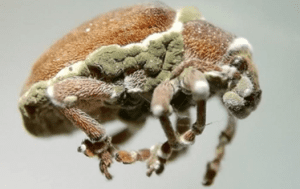TAG: GS 3: ECOLOGY AND ENVIRONMENT
THE CONTEXT: Scientists have found a natural remedy to protect eucalyptus forest plantations from a pest, eucalyptus snout beetle, which is known to cause serious damage to eucalypts.
EXPLANATION:
- Eucalyptus forests, crucial for various industries like paper pulp production, face severe threats from the eucalyptus snout beetle, Gonipterus platensis.
- This beetle, known for causing extensive defoliation and stunted growth, poses a significant risk to eucalyptus plantations globally, affecting over 20 million hectares of forests.
- The beetle’s impact on eucalyptus plantations is substantial, leading to significant losses in wood volume and causing defoliation levels of up to 100 percent in certain regions like the Iberian Peninsula.
- Currently, the primary method to control the pest involves microwasps, an expensive solution that presents challenges in managing the beetle’s population effectively.

Eucalyptus snout beetle infected with pathogenic fungi
Role of Fungi in Pest Management:
- Scientists have identified and characterized natural pathogenic fungi, specifically Beauveria pseudobassiana and Metarhizium brunneum, capable of controlling the eucalyptus snout beetle.
- These fungi offer a promising solution to combat the pest, as they demonstrate high virulence and adaptation to environmental conditions, making them efficient for producing bio-pesticides.
Research Findings and Bio-Insecticide Development:
- The study published in the Biological Control journal emphasizes the effectiveness of Beauveria bassiana, causing 100 percent mortality rates when in contact with the beetle.
- Comparatively, other solutions like Metarhizium anisopliae and Bacillus mixture exhibited lower mortality rates ranging from 2.5 to 5 percent.
Scope and Potential of Fungi-based Solutions:
- The potential of these pathogenic fungi extends beyond Colombia, where the study was conducted, offering a viable solution to combat the eucalyptus snout beetle in other countries facing similar infestation challenges.
- The adaptability of these fungi to environmental conditions presents an opportunity for sustainable forestry management through integrated pest management strategies.
Implications for Sustainable Forestry:
- The development of bio-pesticides using fungi indicates a shift towards sustainable forestry practices, reducing reliance on costly and potentially harmful chemical methods.
- Integrated pest management involving these bio-pesticides could provide a more environmentally friendly and economically feasible approach to controlling the beetle’s population.
Commercial Viability and Mass Production:
- Researchers have focused on assessing the suitability of recovered fungi for mass production and commercialization.
- They’ve evaluated insecticidal activity, UV-B radiation tolerance, and other parameters to ensure the effectiveness and suitability of fungi-based bio-pesticides for widespread application in forestry.
Conclusion:
- The utilization of naturally occurring pathogenic fungi presents a promising avenue to mitigate the damaging effects of the eucalyptus snout beetle on forests globally.
- Through detailed characterization and development of bio-pesticides, scientists aim to offer an eco-friendly and sustainable solution to preserve eucalyptus plantations, vital for various industries relying on these forests.
- This research signifies a significant step towards environmentally conscious pest management in forestry, emphasizing the potential of bio-based approaches in safeguarding vital ecosystems and industries.

